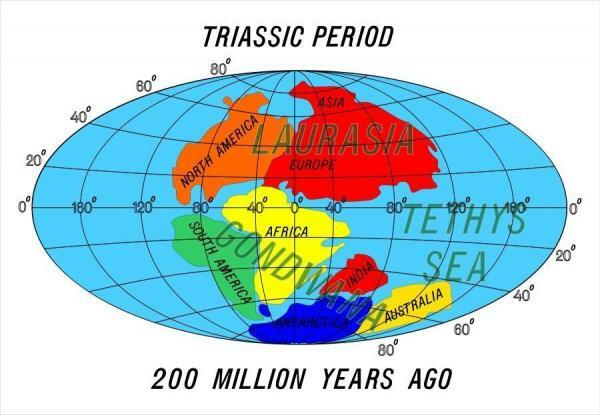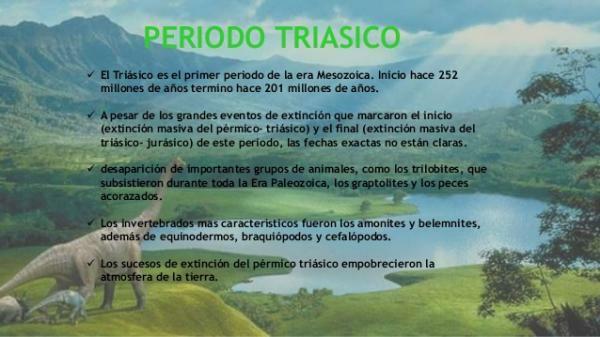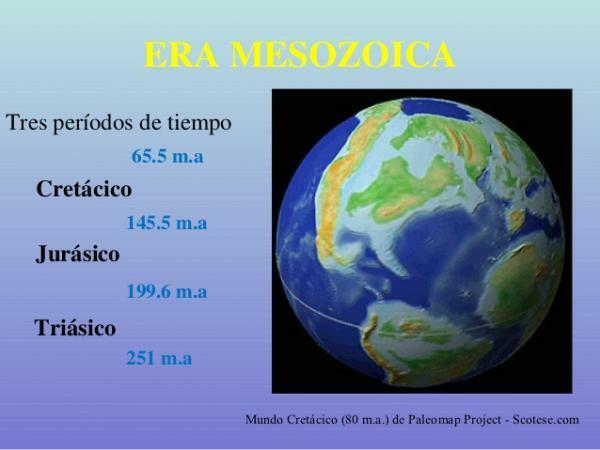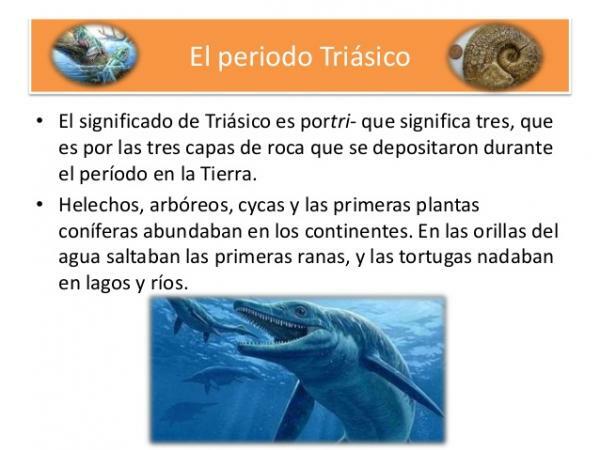Triassic period: main characteristics

Image: Red Historia
The Prehistory It continues to be one of the periods of history that interests us the most, largely due to the mystery that surrounds this entire period. Prehistory is the entire period of our history in which there were still no written sources, so the information we have is due to archaeological discoveries. One of the best known stages of Prehistory is the Triassic and therefore in this lesson from a PROFESSOR we are going to talk about the main characteristics of the Triassic Period.
The Triassic is one of the different geological divisions into which the Mesozoic era (also known by some authors as the Age of the dinosaurs or the Secondary Era), being the first of the three stages that make up this era, preceding the Jurassic and to Cretaceous.
Its name was given by the German geologist Friedrich von Alberti and is given by the term "tri", since three layers of rocks were found when investigating about this time. These three layers are one of red sandstones, another of marine carbonate formations and the third of red clays.
Like all periods of Prehistory, it is difficult to talk about fixed years of beginning and end of the period, only being able to give approximate dates. The period is considered to start 251 million years ago with the Permian-Triassic mass extinction, and ended around 201 million years ago with the Triassic-Jurassic extinction.

Image: SlideShare
Like all the great periods of Prehistory, the Triassic is divided into different sub-periods, all of them with a series of defining characteristics of great relevance. To understand these stages we must mention them, to see their main characteristics and their temporal extension.
Lower Triassic
It is the first of the stages in which the Triassic is divided, extending between ago 252 million years and 247 million years. It was a very hard time for the species that inhabited the Earth, since the Permian-Triassic mass extinction caused very extreme situations. The climate was generally arid and desert, this being one of the reasons why many species could not survive. The most common animal was the Lystrosaurus, who was the one who most easily adapted to the new situation. Regarding its divisions, we can talk about the following:
- Induense.
- Olenekian.
Middle Triassic
This stage lasted between ago 247 million years and 228 million years, being a period marked by the great quantity of ferns and mosses, and by the great importance of the small dinosaurs. The Middle is also divided into two divisions, being the following:
- Anisian.
- Ladinian.
Upper Triassic
The last of the Triassic stages, starting 228 million years ago and ending 201 million years ago. The end of that period begins a great extinction, which wiped out more than 70% of the species that inhabited the Earth at that time. Its divisions are as follows:
- Carniense.
- Norian.
- Rhaetian.

Image: Slideshare
To conclude this lesson on features main characteristics of the Triassic Period, we must talk about the main characteristics of this period, to see its great differences with the Cretaceous and Jurassic. They are as follows:
- Almost all the lands of our planet were united in a kind of supercontinent, which was called Pangea. The continent was totally surrounded by the ocean Panthalassa, except for a part where the ocean was called Tetis. Very little is known about both oceans, as the constant evolution of our planet has caused the sediments in both oceans to disappear.
- Pangea started a slow separation in the late TriassicBut it would not be until later periods that the continents began to take the shape they do now. It must be taken into account that the earth's movements are extremely slow, and that is why in the millions of years that the Triassic lasted there was so little movement of separation.
- The weather predominant of this stage was one very warm, being in many areas desert and arid, due in part to the mass extinction caused at the beginning of the stage. This made the predominant species all those that were able to survive better in this climate.
- There is no evidence of the existence of glaciers, since it is thought that the climate of the poles was temperate and humid, being a perfect habitat for the emergence of new reptiles.
- The plants of this period were able to survive in dry and arid climates, such as the cycads. Some of the most prevalent trees were conifers and ferns. It is thought that certain flowering plants could exist, although the evidence is minimal, and there is a tendency to think that these did not appear until later periods.
- The land surface was dominated by dinosaurs, being the dominant species those that had survived the mass extinction. There was not as much variety of species as in later periods, being able to say that it is the stage of the Mesozoic Era where the dinosaurs were less important.
- Some dinosaurs got a series of membranes on their arms that allow them to glide. The most advanced were pterosaurs, being the first who managed to dominate the air.
- The more abundant groups during the period were the mollusks, being able to be found in all marine areas. It should be taken into account that at this time there was not much variety of species, due to the proximity of the great periods of mass extinction.

Image: Slideshare



